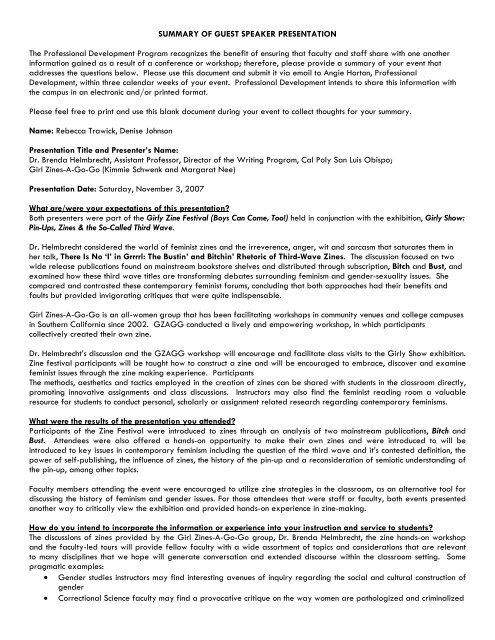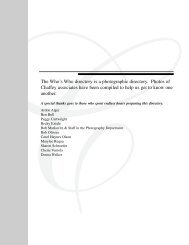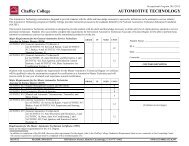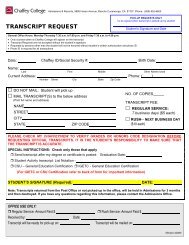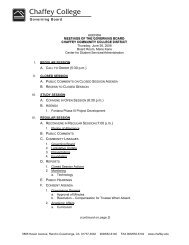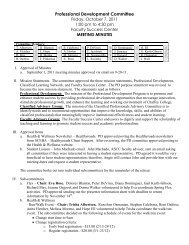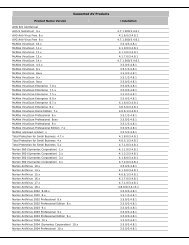Rebecca Trawick Denise Johnson - Chaffey College
Rebecca Trawick Denise Johnson - Chaffey College
Rebecca Trawick Denise Johnson - Chaffey College
You also want an ePaper? Increase the reach of your titles
YUMPU automatically turns print PDFs into web optimized ePapers that Google loves.
SUMMARY OF GUEST SPEAKER PRESENTATION<br />
The Professional Development Program recognizes the benefit of ensuring that faculty and staff share with one another<br />
information gained as a result of a conference or workshop; therefore, please provide a summary of your event that<br />
addresses the questions below. Please use this document and submit it via email to Angie Horton, Professional<br />
Development, within three calendar weeks of your event. Professional Development intends to share this information with<br />
the campus in an electronic and/or printed format.<br />
Please feel free to print and use this blank document during your event to collect thoughts for your summary.<br />
Name: <strong>Rebecca</strong> <strong>Trawick</strong>, <strong>Denise</strong> <strong>Johnson</strong><br />
Presentation Title and Presenter’s Name:<br />
Dr. Brenda Helmbrecht, Assistant Professor, Director of the Writing Program, Cal Poly San Luis Obispo;<br />
Girl Zines-A-Go-Go (Kimmie Schwenk and Margarat Nee)<br />
Presentation Date: Saturday, November 3, 2007<br />
What are/were your expectations of this presentation?<br />
Both presenters were part of the Girly Zine Festival (Boys Can Come, Too!) held in conjunction with the exhibition, Girly Show:<br />
Pin-Ups, Zines & the So-Called Third Wave.<br />
Dr. Helmbrecht considered the world of feminist zines and the irreverence, anger, wit and sarcasm that saturates them in<br />
her talk, There Is No ‘I’ in Grrrrl: The Bustin’ and Bitchin’ Rhetoric of Third-Wave Zines. The discussion focused on two<br />
wide release publications found on mainstream bookstore shelves and distributed through subscription, Bitch and Bust, and<br />
examined how these third wave titles are transforming debates surrounding feminism and gender-sexuality issues. She<br />
compared and contrasted these contemporary feminist forums, concluding that both approaches had their benefits and<br />
faults but provided invigorating critiques that were quite indispensable.<br />
Girl Zines-A-Go-Go is an all-women group that has been facilitating workshops in community venues and college campuses<br />
in Southern California since 2002. GZAGG conducted a lively and empowering workshop, in which participants<br />
collectively created their own zine.<br />
Dr. Helmbrecht’s discussion and the GZAGG workshop will encourage and facilitate class visits to the Girly Show exhibition.<br />
Zine festival participants will be taught how to construct a zine and will be encouraged to embrace, discover and examine<br />
feminist issues through the zine making experience. Participants<br />
The methods, aesthetics and tactics employed in the creation of zines can be shared with students in the classroom directly,<br />
promoting innovative assignments and class discussions. Instructors may also find the feminist reading room a valuable<br />
resource for students to conduct personal, scholarly or assignment related research regarding contemporary feminisms.<br />
What were the results of the presentation you attended?<br />
Participants of the Zine Festival were introduced to zines through an analysis of two mainstream publications, Bitch and<br />
Bust. Attendees were also offered a hands-on opportunity to make their own zines and were introduced to will be<br />
introduced to key issues in contemporary feminism including the question of the third wave and it’s contested definition, the<br />
power of self-publishing, the influence of zines, the history of the pin-up and a reconsideration of semiotic understanding of<br />
the pin-up, among other topics.<br />
Faculty members attending the event were encouraged to utilize zine strategies in the classroom, as an alternative tool for<br />
discussing the history of feminism and gender issues. For those attendees that were staff or faculty, both events presented<br />
another way to critically view the exhibition and provided hands-on experience in zine-making.<br />
How do you intend to incorporate the information or experience into your instruction and service to students?<br />
The discussions of zines provided by the Girl Zines-A-Go-Go group, Dr. Brenda Helmbrecht, the zine hands-on workshop<br />
and the faculty-led tours will provide fellow faculty with a wide assortment of topics and considerations that are relevant<br />
to many disciplines that we hope will generate conversation and extended discourse within the classroom setting. Some<br />
pragmatic examples:<br />
• Gender studies instructors may find interesting avenues of inquiry regarding the social and cultural construction of<br />
gender<br />
• Correctional Science faculty may find a provocative critique on the way women are pathologized and criminalized
• Economics instructors may find the exhibition as a great way to spark conversation on financial inequities between<br />
the sexes<br />
• Political science instructors may find the show to be an interesting entrance into the political contributions of women,<br />
and prohibition thereof, as well as the ramifications of the ERA (if it is ever ratified)<br />
• Art instructors may find the show to be an inspiration for their students to explore new media and styles, and to<br />
utilize their work to voice political and personal concerns<br />
• Creative writing instructors may find very practical applications to their student’s writing and publication of their<br />
own works. The exhibition serves as a resource for material for many English courses and Creative Writing and<br />
Poetry can specifically exploit the focus on zines and self-publishing tactics in the classroom<br />
• Humanities can benefit from the exhibition and related activities in their interdisciplinary approach to the study of<br />
culture and history (Arts and Ideas) and Museum and Gallery Field Study can use the exhibition as an on-campus<br />
resource for their discussions<br />
• Journalism students can use the exhibition as a resource for news writing projects; the viewers/audience of the<br />
exhibition may also be critical to their work<br />
• Philosophy faculty may find the exhibition relates to discussions of ethics, political and personal values, critical<br />
thinking and issues of the self<br />
• Photography faculty will find a great deal of photography represented in the exhibition that can be used to<br />
directly co-relate to classroom lectures. Further, all work in the exhibition relate to discussions of contemporary art<br />
and critical issues<br />
• Psychology can use the exhibition as a resource when discussing issues related to perception<br />
• Sociology will find the exhibition useful in discussions related to social inequality, conditions affecting social change,<br />
popular culture/culture politics, gender issues, marriage and family politics<br />
• Cinema may find the films we’re screening in the Reading Room of interest from a cinematic studies perspective;<br />
the exhibition features three artists showing artists films in Girly Show which can support dialogue in survey,<br />
production and writing coursework<br />
• Communication Studies can use the exhibition as a source for speech-writing assignments<br />
• History faculty can use the exhibition as a resource for HIST-25, Women in United States History in discussions<br />
about the history of feminism as it relates to their discussions<br />
Would you recommend this presenter to speak again in the future? Why or why not?<br />
Yes, if and when the research was relevant to an exhibition or curriculum. The topics are specific in the case of Dr.<br />
Helmbrecht’s presentation, but the GZAGG women could be invited in the future in relation to art, English or other course<br />
work. Both events were highly accessible and interesting and we’d recommend both.<br />
Additional Comments<br />
Thank you for your support of these events. The overall Festival had over 150 visitors to <strong>Chaffey</strong> <strong>College</strong> and the Wignall<br />
Museum. We don’t have data on how many were faculty members, but we hope faculty utilized this unique event to obtain<br />
flex credit and to investigate alternative tools for the classroom.


